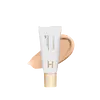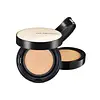Hourglass Cosmetics Veil Hydrating Skin Tint Foundation Versus Jung Saem Mool Essential Skin Nuder Cushion
What's inside
What's inside
 Key Ingredients
Key Ingredients

 Benefits
Benefits

 Concerns
Concerns

 Ingredients Side-by-side
Ingredients Side-by-side

Water
Skin ConditioningCaprylic/Capric Triglyceride
MaskingGlycerin
HumectantLimnanthes Alba Seed Oil
Skin ConditioningPropanediol
SolventSqualane
EmollientC9-12 Alkane
SolventErythritol
HumectantDicaprylyl Ether
EmollientPolyglyceryl-6 Polyricinoleate
EmulsifyingOctyldodecanol
EmollientDisteardimonium Hectorite
StabilisingDistarch Phosphate
AbsorbentPhenoxyethanol
PreservativePolyglyceryl-2 Isostearate
EmulsifyingMagnesium Sulfate
Zinc Stearate
Cosmetic ColorantSodium Benzoate
MaskingSodium Dehydroacetate
PreservativeButyrospermum Parkii Butter Extract
Skin ConditioningHydrogenated Lecithin
EmulsifyingCoco-Caprylate/Caprate
EmollientBenzoic Acid
MaskingPropylene Carbonate
SolventSodium Hyaluronate
HumectantDehydroacetic Acid
PreservativeLecithin
EmollientEthylhexylglycerin
Skin ConditioningTocopherol
AntioxidantAscorbyl Palmitate
AntioxidantNephelium Lappaceum Peel Extract
Skin ConditioningCitric Acid
BufferingStearic Acid
CleansingCI 77891
Cosmetic ColorantCI 77491
Cosmetic ColorantCI 77492
Cosmetic ColorantCI 77499
Cosmetic ColorantWater, Caprylic/Capric Triglyceride, Glycerin, Limnanthes Alba Seed Oil, Propanediol, Squalane, C9-12 Alkane, Erythritol, Dicaprylyl Ether, Polyglyceryl-6 Polyricinoleate, Octyldodecanol, Disteardimonium Hectorite, Distarch Phosphate, Phenoxyethanol, Polyglyceryl-2 Isostearate, Magnesium Sulfate, Zinc Stearate, Sodium Benzoate, Sodium Dehydroacetate, Butyrospermum Parkii Butter Extract, Hydrogenated Lecithin, Coco-Caprylate/Caprate, Benzoic Acid, Propylene Carbonate, Sodium Hyaluronate, Dehydroacetic Acid, Lecithin, Ethylhexylglycerin, Tocopherol, Ascorbyl Palmitate, Nephelium Lappaceum Peel Extract, Citric Acid, Stearic Acid, CI 77891, CI 77491, CI 77492, CI 77499
Water
Skin ConditioningCyclopentasiloxane
EmollientCI 77891
Cosmetic ColorantEthylhexyl Methoxycinnamate
UV AbsorberTrimethylsiloxysilicate
EmollientGlycerin
HumectantEthylhexyl Salicylate
UV AbsorberPEG-10 Dimethicone
Skin ConditioningButylene Glycol
HumectantNiacinamide
SmoothingCetyl Ethylhexanoate
EmollientPentylene Glycol
Skin ConditioningCI 77492
Cosmetic ColorantVp/Hexadecene Copolymer
Caprylyl Methicone
Skin ConditioningPolypropylsilsesquioxane
Magnesium Sulfate
Cetyl PEG/PPG-10/1 Dimethicone
EmulsifyingStearic Acid
CleansingDisteardimonium Hectorite
StabilisingSynthetic Fluorphlogopite
Alumina
AbrasiveAcrylates/Dimethicone Copolymer
Skin ConditioningTriethoxycaprylylsilane
Aluminum Hydroxide
EmollientDimethicone
EmollientEthylhexylglycerin
Skin ConditioningDimethicone Crosspolymer
Emulsion StabilisingAdenosine
Skin ConditioningDimethicone/Vinyl Dimethicone Crosspolymer
Skin ConditioningPolyglutamic Acid
Skin ConditioningDisodium EDTA
Linalool
PerfumingLimonene
PerfumingCitronellol
PerfumingButylphenyl Methylpropional
PerfumingHexyl Cinnamal
PerfumingAlpha-Isomethyl Ionone
PerfumingParfum
MaskingPhenoxyethanol
PreservativeCI 77491
Cosmetic ColorantCI 77499
Cosmetic ColorantMica
Cosmetic ColorantWater, Cyclopentasiloxane, CI 77891, Ethylhexyl Methoxycinnamate, Trimethylsiloxysilicate, Glycerin, Ethylhexyl Salicylate, PEG-10 Dimethicone, Butylene Glycol, Niacinamide, Cetyl Ethylhexanoate, Pentylene Glycol, CI 77492, Vp/Hexadecene Copolymer, Caprylyl Methicone, Polypropylsilsesquioxane, Magnesium Sulfate, Cetyl PEG/PPG-10/1 Dimethicone, Stearic Acid, Disteardimonium Hectorite, Synthetic Fluorphlogopite, Alumina, Acrylates/Dimethicone Copolymer, Triethoxycaprylylsilane, Aluminum Hydroxide, Dimethicone, Ethylhexylglycerin, Dimethicone Crosspolymer, Adenosine, Dimethicone/Vinyl Dimethicone Crosspolymer, Polyglutamic Acid, Disodium EDTA, Linalool, Limonene, Citronellol, Butylphenyl Methylpropional, Hexyl Cinnamal, Alpha-Isomethyl Ionone, Parfum, Phenoxyethanol, CI 77491, CI 77499, Mica
 Reviews
Reviews

Ingredients Explained
These ingredients are found in both products.
Ingredients higher up in an ingredient list are typically present in a larger amount.
Ci 77491 is also hydrated iron III oxide. It's sole purpose is to give a red/pink hue to products.
Iron III oxides are classified as inorganic chemicals for coloring.
Synthetically created Ci 77491 is considered safer than those naturally found. This is because the synthetically created version may contain less impurities. Iron oxides are generally non-toxic and non-allergenic.
Learn more about CI 77491Ci 77492 is also hydrated iron III oxide. It's sole purpose is to give a yellow hue to products.
Iron III oxides are classified as inorganic chemicals for coloring.
Synthetically created Ci 77492 is considered safer than those naturally found. This is because the synthetically created version may contain less impurities. Iron oxides are generally non-toxic and non-allergenic.
Learn more about CI 77492Ci 77499 is also hydrated iron III oxide. It is created from mixing red and black iron oxides. This helps give shades of darkness to a product.
Iron III oxides are classified as inorganic chemicals for coloring.
Ci 77891 is a white pigment from Titanium dioxide. It is naturally found in minerals such as rutile and ilmenite.
It's main function is to add a white color to cosmetics. It can also be mixed with other colors to create different shades.
Ci 77891 is commonly found in sunscreens due to its ability to block UV rays.
Learn more about CI 77891Disteardimonium Hectorite comes from the clay mineral named hectorite. It is used to add thickness to a product.
It can also help stabilize a product by helping to disperse other ingredients.
Hectorite is a rare, white clay mineral.
Learn more about Disteardimonium HectoriteEthylhexylglycerin (we can't pronounce this either) is commonly used as a preservative and skin softener. It is derived from glyceryl.
You might see Ethylhexylglycerin often paired with other preservatives such as phenoxyethanol. Ethylhexylglycerin has been found to increase the effectiveness of these other preservatives.
Glycerin is already naturally found in your skin. It helps moisturize and protect your skin.
A study from 2016 found glycerin to be more effective as a humectant than AHAs and hyaluronic acid.
As a humectant, it helps the skin stay hydrated by pulling moisture to your skin. The low molecular weight of glycerin allows it to pull moisture into the deeper layers of your skin.
Hydrated skin improves your skin barrier; Your skin barrier helps protect against irritants and bacteria.
Glycerin has also been found to have antimicrobial and antiviral properties. Due to these properties, glycerin is often used in wound and burn treatments.
In cosmetics, glycerin is usually derived from plants such as soybean or palm. However, it can also be sourced from animals, such as tallow or animal fat.
This ingredient is organic, colorless, odorless, and non-toxic.
Glycerin is the name for this ingredient in American English. British English uses Glycerol/Glycerine.
Learn more about GlycerinMagnesium Sulfate is a salt. More specifically, it is an epsom salt, or the bath salt used to help relieve muscle aches.
Despite having ‘sulfate’ in the name, it isn’t a surfactant or cleansing agent like sodium lauryl sulfate. Unlike those sulfates, magnesium sulfate doesn’t have the same cleansing or foaming properties (it's simply a type of salt).
In cosmetics, Magnesium Sulfate is used to thicken a product or help dilute other solids. It is a non-reactive and non-irritating ingredient.
One study shows magnesium deficiency may lead to inflammation of the skin. Applying magnesium topically may help reduce inflammation.
You can find this ingredient in sea water or mineral deposits.
Learn more about Magnesium SulfatePhenoxyethanol is a preservative that has germicide, antimicrobial, and aromatic properties. Studies show that phenoxyethanol can prevent microbial growth. By itself, it has a scent that is similar to that of a rose.
It's often used in formulations along with Caprylyl Glycol to preserve the shelf life of products.
Stearic Acid is a fatty acid. It is an emollient, emulsifier, and texture enhancer.
As an emollient, stearic acid helps soften skin. It aids the skin's protective barrier by preventing water loss. It also provides a gentle cleansing effect without stripping away natural oils.
Stearic acid may also be used to enhance the texture of products. It can add volume and stabilize ingredients such as water and oil. This can help water and oil ingredients from separating.
Sources of stearic acid include animal or vegetable fats/oils such as coconut or shea. It can be naturally found in butter, cocoa butter, shea butter, vegetable fats, and animal tallow.
This ingredient may not be Malassezia folliculitis, or fungal-acne safe.
Learn more about Stearic AcidWater. It's the most common cosmetic ingredient of all. You'll usually see it at the top of ingredient lists, meaning that it makes up the largest part of the product.
So why is it so popular? Water most often acts as a solvent - this means that it helps dissolve other ingredients into the formulation.
You'll also recognize water as that liquid we all need to stay alive. If you see this, drink a glass of water. Stay hydrated!
Learn more about Water